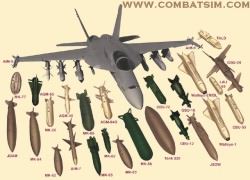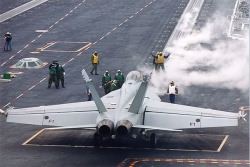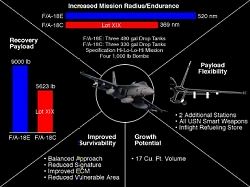|
The F/A-18E/F Super Hornet: A Test Pilot Dispels The Myths By CDR Rob Niewoehner, from www.fas.org |
||||
|
There has been a great deal of interest recently in the press regarding the F/A-18E/F Super Hornet program, its progress through the flight test phase, and the requirements for the airplane in preparation for operational test. Unfortunately, there is a great deal of misinformation and innuendo from various sources that proclaim to be experts on tactical aircraft — and particularly on this airplane. In such an environment, it is important that we review the facts and dispel the myths regarding not only the requirements for the airplane but also its current performance in flight test. Background/Requirement In early 1991 with the cancellation of the A-12, an idea was born out of the Navy’s Hornet 2000 study to develop an affordable, follow-on strike fighter that would capitalize on all of the strengths of the most successful, multi-mission tactical aircraft the Navy had ever developed – the F/A-18C. The F/A-18E/F would improve on the F/A-18C’s capabilities, continuing a series of preplanned product improvements (P3I) into a new airframe that would provide the growth required for the next century. The Navy’s F/A-18C was approaching its limits for further growth, particularly in its carrier suitability weight limit. As a result, the follow-on platform needed to meet several key requirements that would provide improvements over the F/A-18C. As stated in the F/A-18E/F Operational Requirements Document (ORD), "The CINC’s highest priority for the F/A-18 upgrade and the F/A-18 Operational Advisory Group’s number one hardware priority is increased internal fuel; other high priority F/A-18 upgrade requirements include improved carrier suitability and the postulated threat mandate improvements in three key areas: increased mission radius/payload, increased carrier recovery payload, and improved survivability/vulnerability."
 It is these enhancements, with growth for future upgrades, that became the pillars on which the F/A-18E/F was built. All of the requirements of this airplane were to be built inside a "box of affordability," to ensure that the Navy could afford this platform in sufficient numbers to fill its carrier air wings of the 21st century. Myth vs. Fact As the airplane has finished its design phase and entered flight test, conversations with fleet aviators have revealed a number of prevalent F/A-18E/F myths. While these myths and inaccuracies come from various sources, the answers and the facts flow directly from the previously stated requirements. |
 Myth #1 – "The E/F is not a stealthy airplane." Fact – "The E/F is an extremely survivable airplane." Stealth is one approach to survivability — a very expensive approach, whose stand-alone effectiveness is limited to a few mission scenarios. A flexible airplane requires a flexible approach to survivability, one that will deliver significant survivability improvements across the full span of envisioned missions. By balancing the survivability of the E/F (with a combination of reduction in its vulnerable area; signature reduction; employment of defensive systems; and integration of stand-off munitions such as JDAM, JSOW, and SLAM-ER), the airplane capitalizes on all the survivability technologies of the past decade. For example, a glance at the airplane’s physical geometry and exterior features reveals the influence of dedicated radar cross section (RCS) signature control. Where it made good cost-vs.-capability sense, the signature was tailored. For those aspects where additional signature control would have been cost prohibitive, the Navy directed survivability resources elsewhere to get the best return for each survivability dollar. Next, the real measure of survivability is not the likelihood of a single asset’s coming back from any one mission. The real measure of survivability is the number of pilots and airplanes left on the flight deck after a campaign. Similarly, lethality is the number of targets destroyed per aircraft lost. More fuel and more weapon stations will enable the E/F to make fewer sorties into the target area and employ more tactically desirable routes. Fewer sorties and better routing will result in less threat exposure and enhanced survivability. How do more stations contribute to improved survivability? If a strike planner today wanted to put two laser-guided bombs and two High Speed Anti-Radiation Missiles (HARMs) into the battle space, it would require a flight of two C/D aircraft, each most likely configured with two external fuel tanks.
 The strike planner who could employ the F/A-18E/F would be able to get that same load into the target area with one airplane (configured with a single 480-gallon fuel tank). As a bonus, the E/F would be able to carry two AMRAAM on the additional out board stations. It adds up: more weapons, fewer sorties, increased survivability, and greater lethality. Go to Part II
|
|||
|
Copyright © 1997 - 2000 COMBATSIM.COM, INC. All Rights Reserved. Last Updated January 6th, 1999 |
||||
